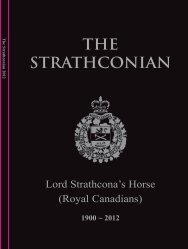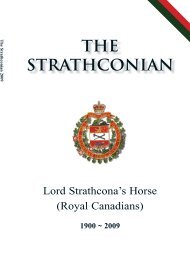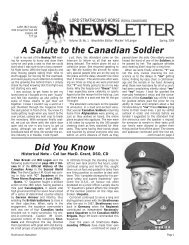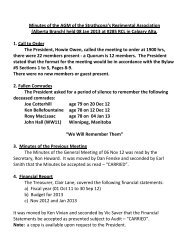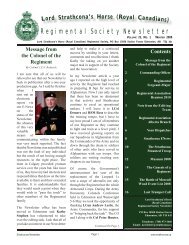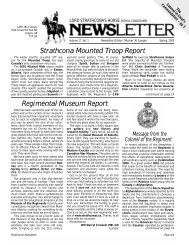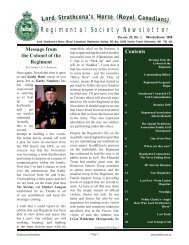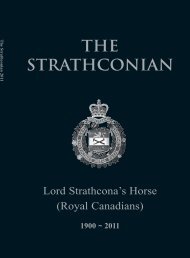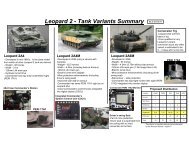The Regimental Manual Second Edition.pdf - Lord Strathcona's Horse
The Regimental Manual Second Edition.pdf - Lord Strathcona's Horse
The Regimental Manual Second Edition.pdf - Lord Strathcona's Horse
Create successful ePaper yourself
Turn your PDF publications into a flip-book with our unique Google optimized e-Paper software.
GENERAL CUSTOMS AND TRADITIONSREGIMENTAL MANUAL3. When the Regiment contains a Reconnaissance Squadron, its letter designation follows that of thelast sabre squadron. Reconnaissance Squadron may be identified as “Recce Squadron” in correspondenceand on parade in accordance with ARTICLE 8202 - Addressing Sub-Units.ARTICLE 2104 - TROOP DESIGNATIONS1. Within squadrons, sabre troops are assigned a numerical prefix commencing with the numberone. On correspondence and on parade, the troops are referred to as First, <strong>Second</strong>, Third or Fourth Troop(not One, Two, Three or Four Troop).2. Functional and service support troops (e.g. Assault Troop or Administration Troop) are referredto by their activity depending on regimental, corps or army practice at the time.ARTICLE 2200 - GENERALSECTION 2 - SENIOR APPOINTMENTS1. <strong>The</strong> following background to senior appointments in the Regiment is an excerpt from Always aStrathcona:“<strong>The</strong> tradition of honorary appointments - such as Honorary Colonel, Colonel of the Regiment,and Colonel Commandant - dates back to the formation of the British regular army in theseventeenth century. In those days the King appointed a person of high standing and wealth to bea colonel to raise a regiment for the Crown; in return the colonel would receive some royalconsideration, such as a title or a lucrative position. <strong>The</strong> Colonel in turn chose an assistant, orLieutenant-Colonel, to recruit, train, and administer the regiment, and lead it in battle. <strong>The</strong>regiment bore the colonel’s name and he maintained a proprietary interest in it, selecting itsofficers and distributing the equipment, pay, and rations provided by the government.“Changing customs and laws have altered the Colonel’s position over the years to the point that itis now primarily an honorary one. A Regiment asks a former officer or other high-rankingindividual to accept the appointment as a mark of their recognition and respect for him. <strong>The</strong>Colonel does not involve himself in the military operation of the Regiment, but is concerned withits ceremonial, social, and ‘family’ aspects, and lends his prestige to the regiment’s activities.” 32. Honorary appointments have evolved to the extent that Honorary Colonels are normallyassociated with Reserve Force units while Colonels of the Regiment are associated with Regular Forceunits. 4 Although the Regiment had several Honorary Colonels between 1903 and 1958, the CanadianArmy replaced the term Honorary Colonel with Colonel of the Regiment in 1958. <strong>The</strong> Regimentcurrently has a Colonel-in-Chief and a Colonel of the Regiment.3 W.B. Fraser, p. 232.4 <strong>The</strong> authority for honorary appointments is Queen’s Regulations and Orders 3.06 (Honorary Appointments) and the rulesgoverning appointments are at Canadian Forces Administrative Order 3-4 (Honorary Appointments and Honorary Ranks).2-2



